Issue: 63 Page: 52-61
Jacob Bigelow's American Medical Botany: Digital Reissue Illuminates Access to Rare Work
by Steven Foster
HerbalGram. 2004; 63:52-61 American Botanical Council
The digital age affords an extraordinary opportunity for history to be resurrected
from rare book rooms and then made available to a wide audience. One such digital
publishing event is Jacob Bigelow’s landmark three volume American Medical
Botany, published in Boston from 1817-1820. Octavo Editions (www.octavo.com)
has recently released a CD-ROM facsimile of this major early nineteenth century
work from a very clean copy in the Cary Graphic Arts collection at the Rochester
Institute of Technology. The digital facsimile is presented as if the book lay
before the viewer imaged as uncropped page spreads. In addition to the crisp digital
facsimile, an introductory commentary work titled “Jacob Bigelow and American
Medical Botany” by special collections librarian Philip Weimerskirch, describes
the book’s significance and Bigelow’s diverse career. A searchable transcription
of the entire three volumes adds to the facsimile’s user friendliness and utility.
Bigelow’s American
Medical Botany represents not only a
milestone in the history of North American medicinal plant literature, but also
an important landmark in printing technology, as the first American book with
printed color plates produced by a method of Bigelow’s own ingenuity.
Jacob M. Bigelow was born in Sudsbury, Massachusetts, on February 27, 1787;
he died just prior to his ninety-second birthday in January of 1879. After a short
stint as a teacher following his graduation from Harvard College in 1806, Bigelow
studied medicine at the University of Pennsylvania Medical School in Philadelphia,
where he developed a passion for botany under the tutelage of Benjamin Smith Barton,
botanical patron and professor of materia medica. Bigelow joined a successful
consulting medical practice, while pursuing botanical interests. In 1814 the first
edition of his Florula Bostoniensis was published, which describes plants
growing within 10 miles of Boston. Two more editions of his Florula Bostoniensis
followed, including an expanded 1822 edition and an 1848 edition which extended
coverage to a much wider area of New England.
In 1815 he became professor
of materia medica at Harvard Medical School. In 1816 he was also appointed
Rumford Professor of the Application of Science to the Useful Arts at Harvard
College. The “useful arts” are what we now call technology. The word technology has its origins in the
seventeenth century, but Bigelow is credited with lifting the term out of
obscurity and being the first to popularize its use both in his lectures and in
a book of collected lectures, Elements of Technology (Boston: Hilliard, Gray & Co., 1829).
At the dawn of the era in
which materia medica was to separate from medicine into the academic discipline
of pharmacy, the incorporated state medical societies of the United States organized
to convene a general convention on the first day of January 1820. The goal was
to compile an American Pharmacopeia. Among the five individuals selected to
serve on a committee to prepare the work for press was Jacob Bigelow. The first
national pharmacopeia of America, The Pharmacopeia of the United States of
America, was published in Boston in
December of 1820. Noting, however, that a pharmacopeia by its nature is
“circumscribed and technical” in 1822, Bigelow authored a commentary on the
pharmacopeia, A Treatise on the Materia Medica Intended as a Sequel to the
Pharmacopeia of the United States
(Boston: Charles Ewer, 1822), a work which conservatively described how
substances were used in practice.
In theoretical medicine,
Bigelow is best remembered for an address delivered to the Massachusetts
Medical Society in 1835 on self-limited diseases—a plea for his colleagues to
refrain from using bloodletting, purging, and other treatments in health
conditions that would resolve themselves without treatment. This and other
essays were collected in a volume published in 1854, Nature in Disease and
Other Writings (Boston: Ticknor and
Fields, 1854). His words remain tireless, reminding his colleagues, “It [our
profession] brings with it the humiliating conclusion, that while other
sciences have been carried forward, with our own time and almost under our own
eyes, to a degree of unprecedented advancement, Medicine, in regard to some of
its professed and most important objects, is still an ineffectual speculation.”
 Bigelow’s
crowning literary jewel was American Medical Botany. Originally issued
in six parts, they were later bound in three volumes dated 1817, 1818, and 1820.
One thousand copies of the work were published. Each volume consists of twenty
plants, accompanied by a full-page color plate (all but three of which were produced
by drawings original to Bigelow’s hand) and descriptive text. There is no systematic
arrangement to the plants in each volume. However, since the drawings were rendered
from live plant material, it somewhat follows a phenological (flowering time)
sequence or perhaps Bigelow’s available time to get to the field and collect the
plant to illustrate. Bigelow’s
crowning literary jewel was American Medical Botany. Originally issued
in six parts, they were later bound in three volumes dated 1817, 1818, and 1820.
One thousand copies of the work were published. Each volume consists of twenty
plants, accompanied by a full-page color plate (all but three of which were produced
by drawings original to Bigelow’s hand) and descriptive text. There is no systematic
arrangement to the plants in each volume. However, since the drawings were rendered
from live plant material, it somewhat follows a phenological (flowering time)
sequence or perhaps Bigelow’s available time to get to the field and collect the
plant to illustrate.
“In a work like the
present,” he wrote, “although we cannot hope to supply all the desiderata of an
indigenous Materia Medica; yet it will be satisfactory to have done something
towards an investigation of the real properties or our most interesting plants,
and to have facilitated a knowledge of them in those, to whom they may be
useful.” He continued. “In a pursuit of this kind, the botanist has views even
beyond the physician. To him it is important not only to know what plants have
properties, that are eminently useful, but also to know, what are the
properties and uses of all the plants which surround him.”
“Under the title of American
Medical Botany, it is my intention to offer to the public a series of coloured
engravings of those native plants, which possess properties deserving the
attention of medical practitioners. The plan will likewise include vegetables
of a particular utility in diet and the arts; also poisonous plants which must
be known to be avoided. In making the selection, I have endeavoured to be
guided by positive evidence of important qualities and not by the insufficient
testimony of popular report. . . I am by no means ambitious to excite an
interest in the subjects of this work, by exaggerated accounts of virtues which
do not belong to them. Much harm has been done in medicine, by the partial
representations of those, who, having a point to prove, have suppressed their
unsuccessful experiments, and brought in to view none but favorable facts.”
Bigelow’s approach was a
conservative one. He chose plants with potential merit based on his own
observations or others “qualified to form correct opinions on the subject.” In
the accompanying text he provides a botanical description, “more diffuse than
is necessary for exclusive botanists,” chemistry with a view toward
pharmaceutical preparations, medical history, and positive evidence of
important medical qualities.
The plates have an aesthetic
quality not common to works of its day. Produced with copper plates through a
process called aquatinting, it is immediately noticeable that the image of the
plant is not outlined in black. Published engravings produced in America at
that time were printed in black outline with the plates colored by hand. This
method was used for the production of the first 100 copies of the first issue
of volume 1. But the speed of his colorists did not please Bigelow, so he
devised a method by which the ink could be applied directly to the printing
plate for the color impression, eliminating the need for hand coloring. This
limited the plates to one or two colors with retouching by hand, but made for
much more efficient printing of the book. Although this method was used elsewhere
in the world, Bigelow seems to have used it for the first time in the United
States. Contemporary reviewers praised the beauty of the plates which were said
to resemble original artwork more than printed engravings. The original three
volumes, which bring prices in excess of $7500 for a complete set in good
condition, is not collected just for its medical or botanical merit, but also
as a landmark work in printing as the first American book with color plates.
Bigelow simply hoped to make a contribution to the American materia medica,
perhaps revealing new drugs which could replace foreign imports. In doing so he
combined the skills of an artist, teacher, botanist, pharmacist, physician, scholar,
and technologist. He knew the plants of which he wrote. He observed them, collected
them; touched, smelled, and tasted each plant part; attempted to distill, decoction,
or triturate them; and finally, if judiciously warranted by his own opinion coupled
with the scientific consensus of the day, use these plants in his medical practice.
He illustrated the plants with his own eye and hand, then brought technological
innovation to bear in developing a suitable method of color printing, a first
for America. Bigelow brought a scientific depth and aesthetic pleasure not only
to the subject of which he wrote and illuminated but also to the publishing and
printing process itself. All these factors combine to make American Medical
Botany rare in the broadest sense, beyond the mere scarcity of today’s physical
copies.
The following pages contain
10 plates, reproduced through the generous permission of Octavo Editions. Brief
commentaries on the plates follow. Names in parentheses represent common or
scientific names used by Bigelow as chapter headers.
Steven Foster is an internationally known author of 45 books on herbal medicine and a renowned photographer of medicinal plants.
His various areas of interest include native American medicinal plants, plant
conservation and sustainable production of medicinal plants, and nineteenth century
herbal literature. Among his many other activities Steven is a Trustee of the
American Botanical Council and his photography regularly illustrates the pages
of HerbalGram. More at www.stevenfoster.com.
Sources:
Gray A. Dr. Jacob Bigelow. The
American Journal of Science and Arts,
Third Series. 1879;17(100):263-266.
Kelly HA. Jacob Bigelow. In: Some American Medical Botanists. Troy,
New York: The Southworth Company Publishers; 1914.
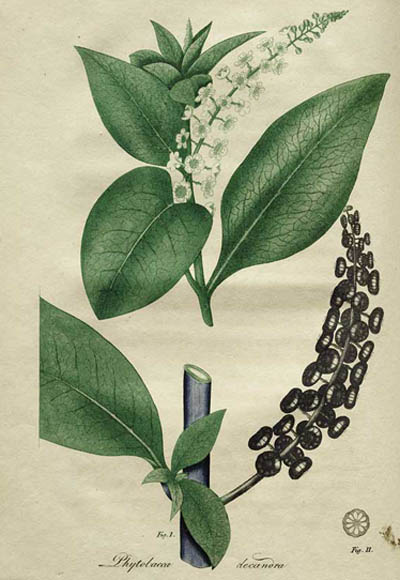
Poke (Phytolacca decandra L.) Phytolacca americana L., Phytolaccaceae, Vol.
1, Plate III, pp. 39-51.
Bigelow’s account of poke speaks not only of its use in America, but in
Europe, where it had become naturalized at least a century earlier. In Portugal
and France, Bigelow wrote, the berries were used to improve the color of red wines
until those countries’ governments banned the practice. Today, the young shoots
are eaten in the South as an early spring green known as “poke salat.” This practice
dates to Bigelow’s day. “The young shoots of this vegetable are destitute of medicinal
qualities, and are eaten in the spring in some parts of the United States, as
substitutes for asparagus,” he wrote. Eating two or three poke berries a year
is still a common folk remedy for rheumatism in the South. He devotes a good deal
of space to the berries, including a description of how a berry preparation can
be used as a more sensitive indicator of acidity than litmus. Bigelow described
the use in rheumatism along with the reputation of the root in external preparations
as a cancer treatment. In his time, professional use focused on poke root as an
emetic, which Bigelow confidently and frequently employed in his practice.
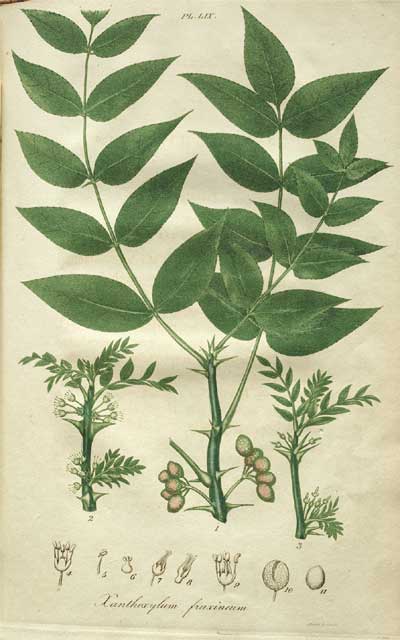
Prickly Ash (Xanthoxylum fraxineum Smith) Zanthoxylum americanum Mill., Rutaceae,
Vol. III, Plate LIX, pp.156-162.
With its distinct numbing sensation produced upon chewing the bark, this
shrub undoubtedly caught the early attention of those interested in the medicinal
flora. Like citrus, prickly ash is a member of the Rutaceae (Rue Family), and
Bigelow describes the lemony fragrance of the leaves as well as the distinct citrus
fragrance of the tiny fruit rind. He distilled the essential oil of the fruits
and leaves, but found that the pungent principle of the bark was not extracted
by distillation, rather by decoction. In addition to exploring the literature
on each plant, we find Bigelow is observed thoroughly smelling, tasting, and testing
each plant part, dissecting it from a botanical perspective, rudimentary chemistry,
experimental pharmacy, and then deducing the therapeutic potential based on this
wealth of experience and knowledge. As explorers were discovering new territories,
Bigelow was exploring the nuances of American medicinal plants. He wrote of prickly
ash’s reputation, both by popular appeal and professional prescription as a much
employed treatment for chronic rheumatism, hence its being stocked in apothecaries.
Bigelow, a stickler for correct nomenclature, stated, “signifying yellow wood,
was originally given by Mr. Colden. The spelling has since been unaccountably
changed to Zanthoxylum in a majority of the books which contain the name.”

American ginseng (Ginseng; Panax quinquefolium) Panax quinquefolius L., Araliaceae,
Vol. II. Plate XXIX, pp. 82-96.
Clearly Bigelow is fascinated with the potential of American ginseng, if
for no other reason than to understand why the Chinese held it in such high esteem
while from the nineteenth century American physician’s perspective, the root seemed
benign at best. Bigelow devoted pages to Jartoux’s now famous early eighteenth
century account of ginseng in China. “Father Jartoux became so far a convert to
the virtues of the plant, that he tells us that after having taken half of a root,
he found his pulse quicker and fuller, his appetite improved, and his strength
increased so as to bear labour better than before.” He concluded, “As far as Ginseng
has been tried medicinally in this country, and in Europe, its virtues do not
appear, by any means, to justify the high estimation of it by the Chinese...Ginseng
is principally sold by our druggists as a masticatory, many people having acquired
an habitual fondness for chewing it. It is certainly one of the most innocent
articles for this purpose.”
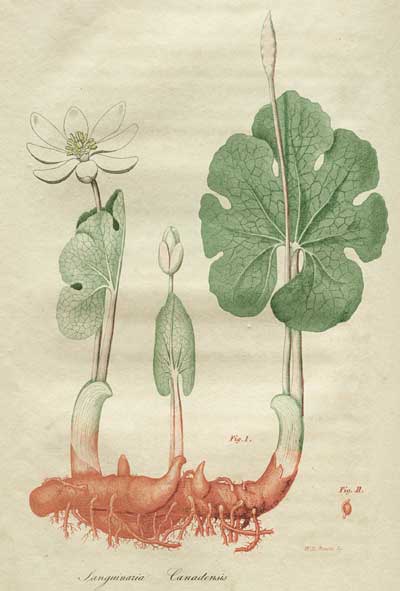
Bloodroot (Blood Root) Sanguinaria canadensis L., Ranunculaceae,
Vol. 1 Plate VII, pp. 75-82.
Bigelow described the medicinal properties as those of an “acrid narcotic.”
“It occasions heartburn, nausea, faintness, and frequently vertigo and diminished
vision.” Enumerating the views of his contemporaries, root preparations found
to be of utility in acute rheumatism, jaundice, diseases of the lung and liver,
influenza, and whooping cough among others. In the hands of a cautious practitioner
he extolled it as “a stimulating tonic, capable of increasing the appetite and
promoting digestion.” In recent years, one of its chief extracted principles (i.e.,
sanguinarine) found use in dental products for antibacterial and antiinflammatory
activities in gingival inflammation and plaque. However, use has been curtailed
since data emerged showing that the compound may cause leukoplakia (precancerous
lesions caused by irritation on the tongue or inside of the cheek). It is also
used in a topical folk cancer remedy “black salve.”
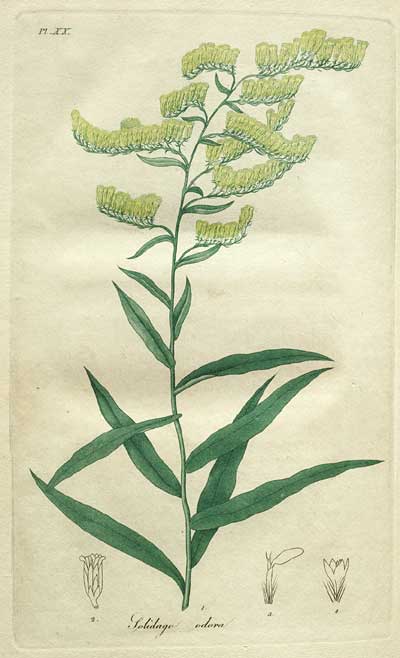
Sweet Goldenrod (Golden Rod, Sweet scented Golden rod.) Solidago odora Aiton,
Asteraceae, Vol. 1, Plate XX, pp. 187-191.
Here the words of Bigelow stand the test of time. “The claims of the Solidago
to stand as an article of the Materia Medica are of a humble, but not despicable
kind. We import and consume many foreign drugs which possess no virtue beyond
that of being aromatic, pleasant to the taste, gently stimulating, diaphoretic
and carminative. All these properties the Golden rod seems fully to possess.”
It is noted, too, as a tea plant, pleasant and aromatic, with a flavor similar
to anise and sassafras, “but different from either.” Today, the herb is still
somewhat of a sleeper (marketwise) as a medicinal tea or extract, but it has become
more widely available in the horticultural trade.
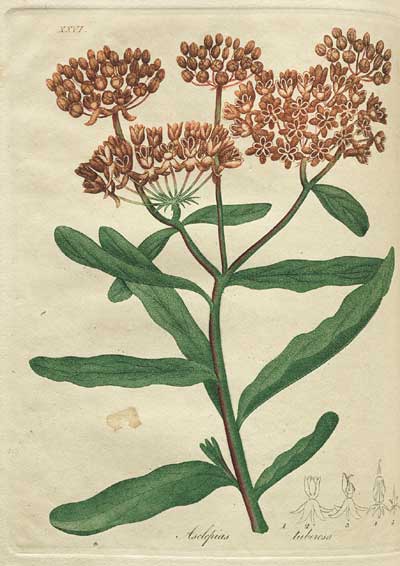
Butterflyweed (Butterfly Weed, Pleurisy Root) Asclepias tuberosa L., Asclepiadaceae,
Vol. II, Plate XXVI. [pp. 59-66]
Bigelow and his contemporaries extolled the use of the root as an expectorant
and diaphoretic. This is a plant drug that has never left the dust of historical
literature for the modern laboratory. What is now known of its virtues comes from
a historical context. Bigelow provided interesting comments on the seed’s silky
fibers. “...it has been substituted for fur, in the manufacture of hats, and for
feathers in beds and cushions. When attached by its ends to any woven fabric,
this down forms a beautiful imitation of the finest and softest fur skins, and
is applicable to various purposes of dress.”

Jimsonweed (Thorn Apple) Datura stramonium L., Solanaceae, Vol. 1, Plate
1. pp. 17-32.
“In common with some other narcotics,” Bigelow explains, “it seems first
to have been introduced freely into practice by Baron Storck of Vienna, as a remedy
in Mania, epilepsy, Convulsions, &c. Many subsequent physicians have given
testimony to its efficacy in certain forms of these disorders, yet the instances
of its failure have doubtless been more frequent than those of its success.”
Bigelow was a
pragmatist. He was loath to accept a plant’s medicinal value short of his own
proof in observation or that of respected colleagues. He dismissed its use in
epilepsy, though he was interested in the drug’s use in the treatment of
asthma. Bigelow also dismissed more ancient traditions. “Many stories have been
related of the power of this and other species of Datura to produce mental
alienation, without at the same time materially affecting the body. [Note C.]
These accounts are generally of somewhat ancient date, and not correspondent
with the observations of later physicians.” Bigelow’s “note C” at the end of
the first volume is a quote from Beverly’s
History of Virginia with an account of soldiers who ate Datura as a spring
green, which turned them into “natural fools” for several days.

Mayapple (May Apple) Podophyllum peltatum L., Berberidaceae, Vol. II. Plate
XXIII, pp. 34-40.
Bigelow ranked mayapple among sure and active cathartics, and thought it
could serve as a substitute for imported stimulant laxatives such as jalap, aloes,
and rhubarb, and considered it “more safe and mild in its operation.” However,
in the appendix in Volume 3 to which Bigelow had promised in the introduction
to add any new information, he quoted an account of Mayapple use by a Dr. Burgon,
who warned, “My experience enables me to state, that it is more drastic than jalap
[Ipomoea purga (Wender.) Hayne, Convolvulaceae], and of course occasions
more active catharsis, more severe griping, and makes a more permanent impression
on the system.” He took a dose of 20 twenty grains then described “…when its operation
commenced and produced continual motions all that day and part of the next night
together with severe tornina.” Such strong cathartic action might warn against
its use, but Burgon adds, “its effects being so decided, I have since prescribed
it in a multitude of cases, and for the most part with similar result.” Apparently,
the stronger the purge the better in the days of professional purging and bloodletting!
Modern interest in mayapple focuses on semisynthetic derivatives of podophyllotoxin
(primarily extracted from the root of the Himalayan mayapple, P. hexandrum)
and its use in chemotherapy for small cell lung cancer and testicular cancer,
among others.
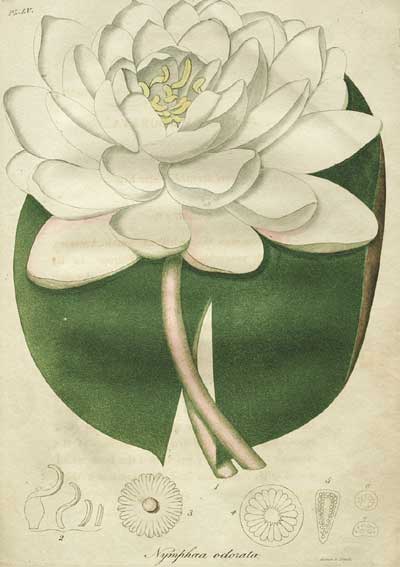
Fragrant Waterlily (Sweet Scented Water Lily) Nymphaea odorata Aiton., Nymphaeaceae,
Vol. III, Plate LV, pp. 134-140.
Bigelow’s ability to weave his love of technological discovery with his
keen delight in beauty in nature is revealed in the treatment of Waterlily. “The
flowers have a delicious odour, hardly surpassed by any perfume with the summer
produces....I have several times attempted to separate this perfume by distillation
both with water and spirit, but have never succeeded in preserving it in the faintest
degree.” Now rare in the herb market, in Bigelow’s day the use of the roots as
a folk medicine and an alternative to then conventional treatment was explained.
“The roots of the water lily are kept by most of our apothecaries, and are much
used by the common people in the composition of poultices....They are occasionally
used by physicians in cases where astringent applications are called for, and
answer a purpose somewhat analogous to that of lead poultices and alum curds.”
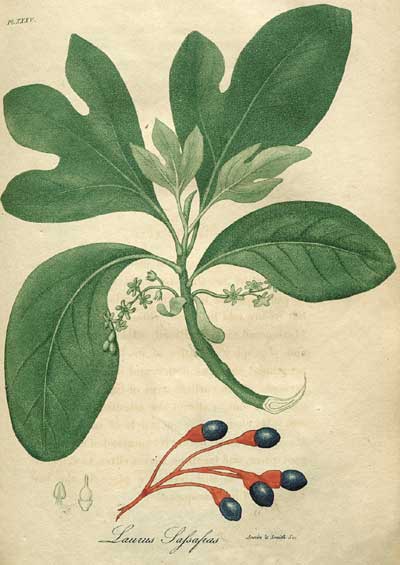
Sassafras (Laurus sassafras L.) Sassafras albidum (Nutt.) Nees., Lauraceae,
Vol. II. Plate XXXV, pp. 142-147.
Bigelow largely dismissed the many virtues once attributed to the bark.
“Its reputation...has fallen into deserved oblivion.” Instead his fascination
focused on the pith of the twigs. “The bark and pith of the young twigs abound
with a pure and delicate mucilage. A very small quantity of the pith infused in
a glass of water gives to the whole a ropy consistence, like the white of an egg.
This mucilage has the uncommon quality that it is not precipitated, coagulated,
or rendered turbid by alcohol....Some eminent surgeons have employed it as a lotion
in the most inflammatory stages of ophthalmia, to which its softness renders it
extremely well suited.”
|